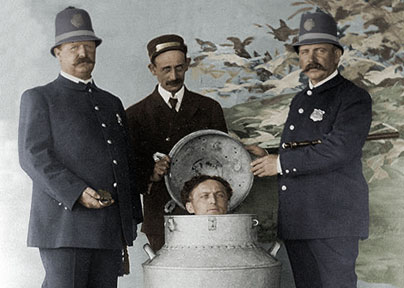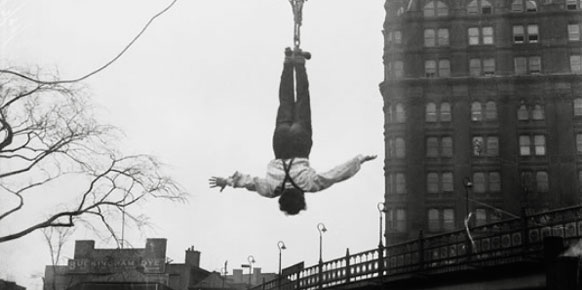 One of the many milk can escapes
One of the many milk can escapes
Houdini's Magic Career
Houdini's early career began in New York beer halls and theaters. Performing for the most part in dime museums, on platforms next to snake charmers, fire-eaters and human oddities, Harry and his brother Theo traveled as far west as Chicago, where the "Brothers Houdini" performed during the 1893 World's Fair. Though word of their talent was spreading, the Houdini's were still struggling financially. As a result, Harry took a job with a traveling medicine show where he pretended to go into a trance and worked as a false medium where he would walk to the front of the stage, close his eyes and pass on messages from the dead. In his later years, Harry would feel so guilty about this that he dedicated his time to debunking these false mediums and psychics.
Harry began his career as a famous escape artist with a trick called "Metamorphosis." In this trick, an assistant, and then later his wife, was placed into a locked box and then switched places with the magician within seconds after a curtain was raised. Harry and his wife Bess played for 26 weeks in 1895 with the Welsh Brothers Circus. Harry also spent his free time pursuing his hobby: handcuffs. He discovered that almost all handcuffs could be opened with a single key or piece of bent metal. He read every piece of information that he could find on locking mechanisms and began collecting different kinds of cuffs and keys, taking them apart and studying their mechanisms. Eventually, Houdini would make go from town to town making a show of escaping not only standard police handcuffs, but also any "trick" handcuffs brought by spectators. At this point, Houdini became known as "The Handcuff King".
Houdini continued his career of escape by introducing the straitjacket escape into his routine. After obtaining a straitjacket and weeks of practice, Houdini was ready to try the trick on stage. He was buckled in, carried to a cabinet and then placed behind curtains. He had gained some slack by holding his crossed arms rigidly as the sleeve straps were fastened. Straining every muscle, a little at a time, he forced one sleeve and then other over his head. Then, he opened the straps with the pressure of his fingers through the canvas. He twisted, turned, and finally squirmed free. He threw off the restraint and burst through the curtains to take a bow.
As the Houdini's fame spread throughout the United State, Harry and Bess became eager to travel abroad. Houdini and Bess sailed for England where Harry had to convince a club manager that he could escape from handcuffs at Scotland Yard before the manager would give him his first British contract. Harry was successful in his escape and in July 1900, he opened at the Alhambra Theater in London and then traveled to the Continent, where he set new box-office records in Dresden and Berlin. Within a year, Houdini was the most popular attraction in Europe.
When Houdini returned to America he found that his fame in Europe had been widely told at home and he was soon selling out theaters all over the country. During this time, Houdini introduced his escape from a padlocked water can at the Columbia Theatre in St. Louis in January 1908, now known as the "Chinese Water Torture" trick. On January 7, 1918, Houdini introduced the biggest illusion ever staged at the New York Hippodrome, or anywhere else. He called it the "Vanishing Elephant". As a result of this new trick's popularity, Houdini's engagement was prolonged to 19 weeks, the longest that Houdini had ever played.







